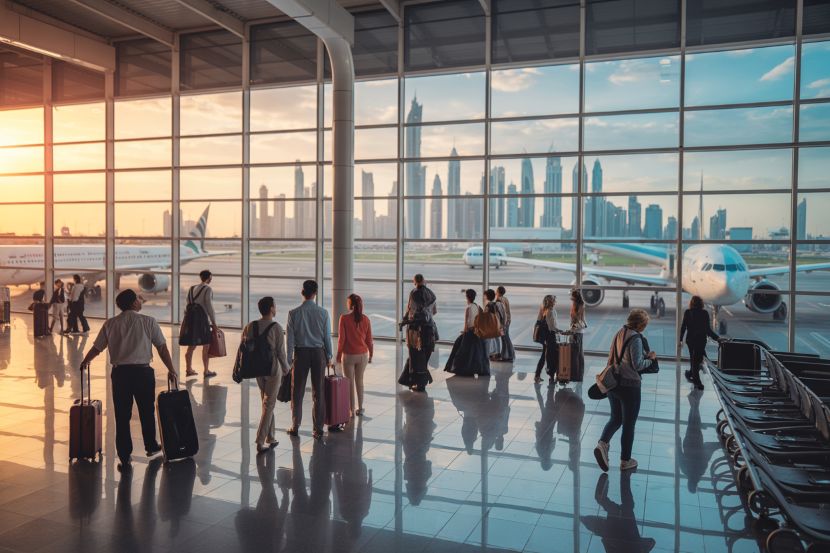WTTC Report: International Travel and Tourism to Support Ninety Million Jobs by 2035, with Middle East Growth Highlighted – Travel And Tour World

Report on Global Travel and Tourism Sector’s Contribution to Sustainable Development Goals
Executive Summary
A recent report from the World Travel & Tourism Council (WTTC), titled ‘Future of the Travel and Tourism Workforce’, projects significant growth in the global travel and tourism sector. The industry is forecast to generate ninety million new jobs by 2035, directly contributing to the United Nations Sustainable Development Goals (SDGs), particularly SDG 8 (Decent Work and Economic Growth). This expansion, however, is contrasted by a potential global workforce shortfall of over 43 million people, necessitating strategic interventions aligned with SDG 4 (Quality Education) and SDG 17 (Partnerships for the Goals). The Middle East, led by Saudi Arabia, is highlighted as a key driver of this growth, with substantial investments in infrastructure that support SDG 9 (Industry, Innovation, and Infrastructure).
Economic Growth and Job Creation: Aligning with SDG 8
Global Employment and Economic Projections
The report indicates a robust post-pandemic recovery and expansion, with the sector’s economic contributions and employment opportunities directly supporting the targets of SDG 8.
- Job Creation: The sector is projected to create 90 million new jobs over the next decade, accounting for one in every three new jobs created worldwide. This directly addresses Target 8.5 of promoting full and productive employment and decent work for all.
- GDP Contribution: The travel sector’s GDP contribution grew by 8.5% in 2024, reaching USD 10.9 trillion. This figure surpasses pre-pandemic levels by 6% and underscores the industry’s role in achieving Target 8.2, which aims for higher levels of economic productivity.
Addressing Sectoral Challenges through the SDG Framework
Projected Workforce Shortfall
Despite positive growth, the report warns of a significant labor shortage that could impede the sector’s contribution to sustainable development. The global workforce availability is projected to be 16% below required levels by 2035.
- China: Expected to face the largest gap with a shortfall of 16.9 million workers.
- India: A projected shortfall of 11 million workers.
- European Union: A projected gap of 6.4 million workers.
Strategic Responses and SDG Integration
The WTTC emphasizes the need for collaborative action to mitigate these challenges, aligning with several SDGs.
- SDG 4 (Quality Education): Addressing the skills gap requires a focus on training and upskilling the workforce. This aligns with Target 4.4, which seeks to increase the number of adults with relevant skills for employment and decent jobs.
- SDG 10 (Reduced Inequalities): The call for fostering inclusive growth ensures that employment opportunities are accessible, contributing to the reduction of inequalities within and among countries.
- SDG 17 (Partnerships for the Goals): The report stresses the need for collaborative efforts between governments and businesses to build resilient travel systems and tackle labor challenges, reflecting the principles of public-private partnerships outlined in SDG 17.
Regional Spotlight: The Middle East’s Role in Sustainable Tourism Development
Saudi Arabia’s Vision 2030 and Infrastructure Investment
The Middle East, particularly Saudi Arabia, is presented as a leading region in tourism recovery and growth, with national strategies that embody sustainable development principles.
- Infrastructure Development: Saudi Arabia’s Vision 2030 is guiding massive investments in world-class tourist infrastructure, including hotels, resorts, and entertainment facilities. This development is a direct contribution to SDG 9 (Industry, Innovation, and Infrastructure), which calls for building resilient infrastructure to support economic development.
- Economic Diversification: The region’s thriving tourism sector, attracting significant international investment and visitor spending, showcases a successful model for economic diversification and resilience, a core objective of SDG 8.
Sustainable Development Goals (SDGs) Analysis
-
Which SDGs are addressed or connected to the issues highlighted in the article?
The article primarily addresses issues related to economic growth, employment, and partnerships within the global travel and tourism sector. The following SDGs are directly connected:
-
SDG 8: Decent Work and Economic Growth
This is the most prominent SDG in the article. The text focuses extensively on job creation, the economic contribution of the tourism sector, and its role in fostering global economic growth. Phrases like “generate ninety million new jobs,” “travel sector’s GDP contribution grew by 8.5%,” and “fostering economic growth across the globe” directly link the article’s content to this goal.
-
SDG 4: Quality Education
The article implies a connection to SDG 4 by highlighting a significant challenge in the tourism sector: a “workforce shortfall of over 43 million people” and a “gap in the availability of skilled workers.” The call for “training and upskilling the workforce” to address this impending labor shortage directly relates to the goal of ensuring inclusive and equitable quality education and promoting lifelong learning opportunities for employment.
-
SDG 17: Partnerships for the Goals
The article underscores the importance of collaboration to achieve sustainable growth. The role of the World Travel & Tourism Council (WTTC) as a global body, the mention of its Global Summit, and its call for “collaborative efforts” between “governments and businesses” to tackle labor challenges highlight the need for multi-stakeholder partnerships, which is the core of SDG 17.
-
-
What specific targets under those SDGs can be identified based on the article’s content?
Based on the article’s discussion of job creation, economic performance, skills gaps, and collaboration, the following specific targets can be identified:
-
Targets under SDG 8 (Decent Work and Economic Growth)
- Target 8.1: Sustain per capita economic growth in accordance with national circumstances and, in particular, at least 7 per cent gross domestic product growth per annum in the least developed countries. The article supports this by stating the “travel sector’s GDP contribution grew by 8.5% in 2024, reaching an impressive USD 10.9 trillion.”
- Target 8.5: By 2030, achieve full and productive employment and decent work for all women and men, including for young people and persons with disabilities, and equal pay for work of equal value. The projection that the industry will “generate ninety million new jobs” and that these will account for “one out of three new jobs created around the world” directly relates to this target of achieving full employment.
- Target 8.9: By 2030, devise and implement policies to promote sustainable tourism that creates jobs and promotes local culture and products. The entire article, which discusses the growth of the tourism sector and its role in job creation, is aligned with this target. The focus on Saudi Arabia’s “Vision 2030” and its investments in “world-class tourist infrastructure” is a clear example of a national policy promoting tourism for job creation.
-
Target under SDG 4 (Quality Education)
- Target 4.4: By 2030, substantially increase the number of youth and adults who have relevant skills, including technical and vocational skills, for employment, decent jobs and entrepreneurship. The article’s warning of a “workforce shortfall” and a “gap in the availability of skilled workers,” coupled with the call for “training and upskilling,” directly points to the need to achieve this target to ensure the sector’s sustainable growth.
-
Target under SDG 17 (Partnerships for the Goals)
- Target 17.17: Encourage and promote effective public, public-private and civil society partnerships, building on the experience and resourcing strategies of partnerships. The article highlights the role of the WTTC, a civil society/private sector body, in conducting research and convening summits. The call for “collaborative efforts” between governments and businesses to address labor shortages is a direct reference to the need for such partnerships.
-
-
Are there any indicators mentioned or implied in the article that can be used to measure progress towards the identified targets?
The article provides several quantitative and qualitative indicators that can be used to measure progress:
-
Indicators for SDG 8
- For Target 8.1: The article provides a direct indicator of economic growth by stating the “travel sector’s GDP contribution grew by 8.5% in 2024.” The total contribution of “USD 10.9 trillion” also serves as a baseline measurement.
- For Target 8.5 & 8.9: The projection of “ninety million new jobs” by 2035 is a key indicator for measuring employment growth in the sustainable tourism sector. The ratio that this represents “one out of three new jobs created around the world” is another powerful indicator of the sector’s contribution to global employment.
-
Indicators for SDG 4
- For Target 4.4: The article provides a clear indicator of the skills gap with the projection of a “workforce shortfall of over 43 million people” by 2035. It also states that “workforce availability… is projected to be 16% below required levels.” These figures can be used to measure the gap between the demand for skilled labor and its supply, and progress can be tracked by monitoring the reduction of this shortfall through training and upskilling initiatives.
-
Indicators for SDG 17
- For Target 17.17: The article implies indicators of partnership through its mention of “international investments in tourism” in Saudi Arabia and the central role of the WTTC in bringing together industry leaders and governments at its “Global Summit.” The existence and actions of such collaborative bodies and the flow of international investment are qualitative and quantitative indicators of partnership effectiveness.
-
-
Create a table with three columns titled ‘SDGs, Targets and Indicators” to present the findings from analyzing the article.
SDGs Targets Indicators Identified in the Article SDG 8: Decent Work and Economic Growth 8.1: Sustain per capita economic growth. 8.5: Achieve full and productive employment.
8.9: Promote sustainable tourism that creates jobs.
– Growth of the travel sector’s GDP contribution (8.5% in 2024).
– Total GDP contribution (USD 10.9 trillion).
– Number of new jobs to be created (ninety million by 2035).
– Proportion of new jobs created globally (one out of three).SDG 4: Quality Education 4.4: Increase the number of adults with relevant skills for employment. – Projected workforce shortfall (over 43 million people by 2035).
– Percentage of workforce availability below required levels (16%).
– Qualitative need for “training and upskilling the workforce.”SDG 17: Partnerships for the Goals 17.17: Encourage and promote effective public-private and civil society partnerships. – Existence and actions of the World Travel & Tourism Council (WTTC).
– Mention of “collaborative efforts” between governments and businesses.
– Flow of “international investments in tourism” (e.g., in Saudi Arabia).
Source: travelandtourworld.com
What is Your Reaction?
 Like
0
Like
0
 Dislike
0
Dislike
0
 Love
0
Love
0
 Funny
0
Funny
0
 Angry
0
Angry
0
 Sad
0
Sad
0
 Wow
0
Wow
0



















































.jpg.webp?itok=0ZsAnae9#)

























